

L’agroécologie, l’être humain dans sa responsabilité à l’égard du vivant. « La terre… Combien sommes-nous à comprendre cette glèbe silencieuse que nous foulons durant toute notre vie, quand nous ne sommes pas confinés dans des agglomérations hors-sol qui nous la rendent encore plus étrangère?
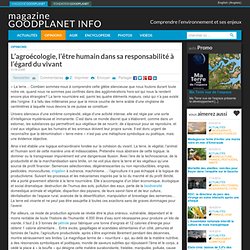
La terre nourricière est, parmi les quatre éléments majeurs, celui qui n’a pas existé dès l’origine. Il a fallu des millénaires pour que la mince couche de terre arable d’une vingtaine de centimètres à laquelle nous devons la vie puisse se constituer. Univers silencieux d’une extrême complexité, siège d’une activité intense, elle est régie par une sorte d’intelligence mystérieuse et immanente. C’est dans ce monde discret que s’élaborent, comme dans un estomac, les substances qui permettront aux végétaux de se nourrir, de s’épanouir pour se reproduire, et c’est aux végétaux que les humains et les animaux doivent leur propre survie.
Videos. The Ugandan Government’s willingness to allow foreign companies access to Ugandan land, and forest, is leading to the displacement of local communities and the destruction of their traditional way of life.
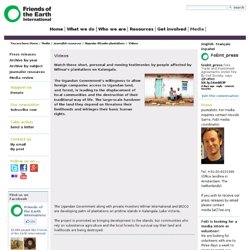
The large-scale handover of the land they depend on threatens their livelihoods and infringes their basic human rights. The Ugandan Government along with private investors Wilmar International and BIDCO are developing palm oil plantations on pristine islands in Kalangala, Lake Victoria. The project is promoted as bringing development to the islands, but communities who rely on subsistence agriculture and the local forests for survival say their land and livelihoods are being destroyed. Diminution des ressources naturelles. Think On Your Own. Tropical croplands expand by 48m ha in 10 years, raising environmental concerns. Conversion of forest to oil palm plantations in Borneo.
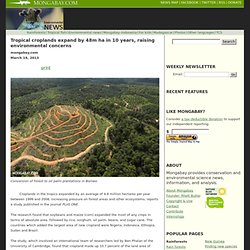
Croplands in the tropics expanded by an average of 4.8 million hectares per year between 1999 and 2008, increasing pressure on forest areas and other ecosystems, reports a study published in the journal PLoS ONE. The research found that soybeans and maize (corn) expanded the most of any crops in terms of absolute area, followed by rice, sorghum, oil palm, beans, and sugar cane. The countries which added the largest area of new cropland were Nigeria, Indonesia, Ethiopia, Sudan and Brazil. The study, which involved an international team of researchers led by Ben Phalan of the University of Cambridge, found that cropland made up 10.7 percent of the land area of tropical countries, about 10 percent less than the global figure of 12 percent. Rice is the most widely grown crop in the tropics, including rainforests and tropical dry forests.
The study also forecasts areas vulnerable to future conversion due to high cultivation potential. Matières premières : L'humanité épuise les ressources naturelles Un rapport de l'ONU avertit que si la croissance mondiale reste aussi gourmande en matières premières, leur consommation triplera d'ici à 2050.

Si l'humanité continue sur sa lancée, elle consommera en 2050 trois fois plus de matières premières qu'aujourd'hui. «Bien au-delà de ce qui est supportable.» L'avertissement est clair. Et il ne provient ni de Lester Brown, président du Earth Policy Institute qui multiplie depuis des décennies les livres sur l'épuisement des ressources de la planète, ni du WWF ou de Greenpeace mais de l'ONU. Earth: Your Fragile Planet. Urbanisation.
MAN. World Population Day 2013: 7 Billion Earthlings, and Counting. I made an eye-opening error in commuting yesterday when I walked through Times Square at midday on an incredibly steamy July day.
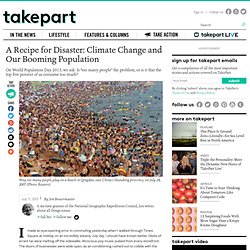
I should have known better. Globs of errant tar were melting off the sidewalks. Atrocious pop music pulsed from every storefront. The doors of businesses were wide open, as air-conditioning rushed out to collide with the exorbitant heat. People were jammed shoulder-to-shoulder for several blocks, sweating and shouting. “Who are all these people?” The stats are stunning: Since 1800, the planet’s population has grown by seven-fold; during the same time period carbon dioxide emissions have grown by 150 times. Later in the day, with tornado winds whipping across the midsection of the country, I watched flight after flight cancel on the big board at Newark Airport. “Who are all these people?” There are too many of us! The biggest concern then was the world simply not being able to feed the growing population (then four billion). Humanity Imperiled: The Path to Disaster. Truthout doesn’t take corporate funding - that’s how we’re able to confront the forces of greed and regression, with no strings attached.
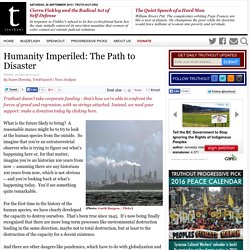
Instead, we need your support: make a donation today by clicking here. (Photo: Garth Burgess / Flickr)What is the future likely to bring? A reasonable stance might be to try to look at the human species from the outside. So imagine that you’re an extraterrestrial observer who is trying to figure out what’s happening here or, for that matter, imagine you’re an historian 100 years from now -- assuming there are any historians 100 years from now, which is not obvious -- and you’re looking back at what’s happening today. You’d see something quite remarkable. For the first time in the history of the human species, we have clearly developed the capacity to destroy ourselves.
And there are other dangers like pandemics, which have to do with globalization and interaction. How to Destroy a Planet Without Really Trying There have been a range of reactions.